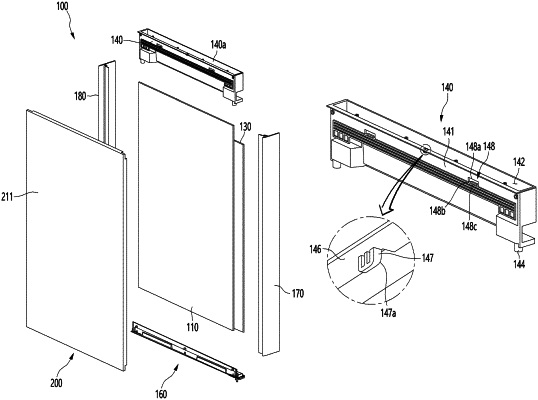| CPC F25D 23/028 (2013.01) [A47B 96/20 (2013.01); A47B 2096/207 (2013.01); A47B 2096/208 (2013.01); A47B 2096/209 (2013.01)] | 20 Claims |

|
1. A refrigerator comprising:
a cabinet that defines a storage space; and
a door configured to open and close at least a portion of the storage space, the door comprising:
a frame that (i) includes an upper frame portion that protrudes toward a front of the refrigerator, the upper frame portion including a coupling protrusion that extends downward, (ii) includes a lower frame portion that protrudes toward the front of the refrigerator, and (iii) defines an insulating space between the upper frame portion and the lower frame portion configured to receive insulating material, the lower frame portion defining a coupling hole, and
a panel that is configured to be detachably coupled to the frame and that defines an outer appearance of the door, the panel being made from metal and including (i) an upper extension part that is bent rearward to extend in a rearward direction, (ii) a lower extension part that is bent rearward to extend in the rearward direction, and (iii) a pair of side extension parts that are bent rearward to extend in the rearward direction, each of the pair of side extension parts comprising a first bent portion that extends reward relative to a rear surface of the panel and a second bent portion that is bent from the first bent portion and faces the rear surface of the panel,
wherein the upper and lower frame portions of the frame are configured, based on the panel being coupled to the frame, to partially cover at least a portion of the upper extension part and the lower extension part, respectively,
wherein the upper extension part of the panel defines one or more openings configured to receive the coupling protrusion to thereby couple the upper extension part to the upper frame portion,
wherein the upper extension part includes a first upper extension part that extends a first upper extension length in the rearward direction and a second upper extension part that extends a second upper extension length in the rearward direction, the second upper extension length being greater than the first upper extension length, and the one or more opening of the upper extension part being defined at the second upper extension part, and
wherein the lower extension part of the panel defines one or more openings configured to be aligned with the coupling hole of the lower frame portion to thereby receive a fastening member that is inserted sequentially into the coupling hole and then into the one or more openings to thereby couple the lower extension part to the lower frame portion.
|